

As my dear old Dad used to say, "You'll miss me when I'm gone." I think that's true, not just for people, but for inanimate objects too, like certain trains, or in this particular instance, interurbans. Without giving away my age, British Columbia Electric Railway (BCER) was still operating interurbans when I was growing up in Vancouver. I can recall the wood trestle across False Creek to Kitsilano and their workshops located there. The Arbutus Corridor still had track on it back then that carried interurbans south to Marpole.
Today you will find only five interurbans left in Vancouver of the many that used to work as far east as Chilliwack. Two of these are still operable and currently run on a short section of old right-of-way between Granville Island and Leg-in-Boot station on the south side of False Creek. However, times they are a changing, and plans are afoot that will effect these trams so read on to be brought up-to-date on the current state of affairs.
are still operable and currently run on a short section of old right-of-way between Granville Island and Leg-in-Boot station on the south side of False Creek. However, times they are a changing, and plans are afoot that will effect these trams so read on to be brought up-to-date on the current state of affairs.
There are some twenty photographs included with this article showing the interurbans, structures, and equipment currently operational or under restoration as of 2008.
included with this article showing the interurbans, structures, and equipment currently operational or under restoration as of 2008.
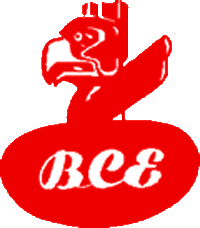
For the British Columbia Electric Railway Company history began when a railway company named Vancouver & Lulu Island Railway (V&LI) was incorporated in 1891. This company constructed a line from Vancouver to Steveston via Marpole .
.
The original intention was to provide a rail link for workers and canned products between Steveston and Vancouver. By 1905, the BCER leased the Vancouver and Lulu Island Railway from the Canadian Pacific Railway (CP), using a steam engine for this portion of the line. The train was quickly dubbed the "Sockeye Limited". While cannery workers were happy to use the train themselves, they were skeptical about using it for transporting the canned salmon products, fearing the extra handling that this method would cause. After some time and experience, the canning industry found that shipping their products by rail was only economical for long distance shipping. Short distance shipping was more feasible and more direct by boat.
for this portion of the line. The train was quickly dubbed the "Sockeye Limited". While cannery workers were happy to use the train themselves, they were skeptical about using it for transporting the canned salmon products, fearing the extra handling that this method would cause. After some time and experience, the canning industry found that shipping their products by rail was only economical for long distance shipping. Short distance shipping was more feasible and more direct by boat.
Farmers in the area were happy to use the railway to ship their products, especially when they received a discount from the BCER. The interurban was a quick and efficient way to get their milk and fresh produce to its destination. Soon, farm products, shingles, and sawmill products, became the most prolific users of the railway.
In 1905, the line was converted to electric and continued to run as such for the next 50 years. Four interurbans worked the interurban line. Each travelled at an average speed of 20-25 mph, but could reach speeds of 45-55 mph on occasion. A link was completed in 1909 to provide service on the Steveston line between Marpole and New Westminster . This painting by Max Jacquiard
. This painting by Max Jacquiard shows what the New Westminster terminal looked like in 1950.
shows what the New Westminster terminal looked like in 1950.
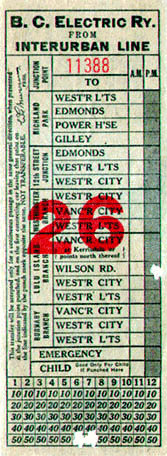
By 1910 the company was calling for tenders to construct their Carrall Street station in Vancouver. A line between New Westminster and Chilliwack opened in 1910 when the BC Electric next acquired the dormant railway charter of the Fraser Valley & Southern Railway Company enabling it to construct its Fraser Valley line. This line was used to primarily handle logs and lumber, although it did also offer passenger service. In 1911, a third line linked New Westminster via Burnaby.
in Vancouver. A line between New Westminster and Chilliwack opened in 1910 when the BC Electric next acquired the dormant railway charter of the Fraser Valley & Southern Railway Company enabling it to construct its Fraser Valley line. This line was used to primarily handle logs and lumber, although it did also offer passenger service. In 1911, a third line linked New Westminster via Burnaby.
Most of the lines were improved in 1911 and 1912 to allow for double tracks and improve steep grades in certain areas. The system remained relatively unchanged through World War Two, after which management decided to ease out of passenger operations due to the increased use of buses. Most lines were abandoned in the early 1950's, while the Steveston line was maintained until 1958, largely due to the deficiencies of Richmond's streets.
While in service, the interurbans provided passengers with a social and often amusing method of transportation along the fifteen mile trip between Vancouver and Steveston. A return fare cost 85 cents for regular passengers, 60 cents for commercial travellers, and half fare for clergymen. Children rode for free. The interurbans were often full on Friday and Saturday nights as Richmond residents made their way to and from the Pantages and Orpheum theatres in Vancouver. The last interurban of the night (running between 12 midnight and 01:00), became known as the "peanut special" because of all the shells dropped on the floor. Vancouverites used the interurbans to attend the Steveston Opera House. Interurbans that transported fans to the horse racing at Brighouse track were said to be the most lively rides of all.
Sometime during the 1950's diesel locomotives started to provide freight service to Chilliwack with the last electric freight and express service running there in October 1970. In 1958 passenger interurbans ceased operating on all BCER lines.
service running there in October 1970. In 1958 passenger interurbans ceased operating on all BCER lines.
By 1992, seven of the interurban cars still existed, five of which were already refurbished and settled in transportation museums (such as the Royal British Columbia Museum and the National Museum of Transportation in Ottawa).
BC Electric also ran an electric railway service on Vancouver Island, but that's a story for another day.
Interurban 1207 was one of three built at New Westminster to inaugurate service from Marpole to Steveston in 1905. Originally named the "Steveston", it was destined, along with three other cars, to close out the same line on 28 Feb 1958, the last remaining BCER interurban route, bringing to an end all electric rail passenger service in British Columbia until the introduction of SkyTrain in 1986. After retirement, the car was bought by two Seattle residents who stored the car at the Snoqualmie Falls Railway Museum in Washington state until the car was acquired by BC Transit in 1989 for restoration in conjunction with the transit centennial in 1992. The City of Vancouver has now renewed the lease of BCER 1207 for another five years, for operation on the Downtown Historic Railway. The car is parked in the car barn located on West 6th Avenue between Heather and Ash Streets. It continues to please many riders, as it did almost 100 years ago, now operating between Leg-in-Boot and Granville Island stations - The Transit Museum Society (TRAMS).
Interurban 1220 has found a permanent home in Steveston Park. 1220 was built in St. Louis Missouri, by the St. Louis Car Company in 1913. It was purchased by the BCER to carry passengers from Vancouver to Steveston. It worked long and hard, primarily on the Steveston interurban line, until cessation of service in February of 1958. It operated a total of 45 years, carrying passengers of all ages through an era that relied heavily on public transportation. BCER 1220 was brought to Steveston after a 35 year absence through the efforts of the Steveston Interurban Restoration Society. Since 1993 the car has greeted thousands of visitors at a temporary location at the foot of No. 1 Road and Bayview Street. In 1995 the Society obtained permission and financial assistance from the City to relocate BCER 1220 to Steveston Park, on track originally placed in 1902 by the CP and used by BCER 1220 during her active years - City of Richmond 21 Oct 2007.
In 1912 the BC Electric placed their largest order for tram cars, purchasing thirty-two 1200 series cars from the St. Louis Car Company, including BCER 1223. The car entered service in 1913, and ran throughout the Lower Mainland for 45 years. In the 1950s, electric railway service was replaced by buses so the 1223 was retired from service in 1958. It was one of only seven BC Electric interurbans that was saved from destruction. The car became the property of the Burnaby Historical Society. The Society put it on display at Edmonds Loop, at Kingsway and Edmonds. During the 1960's the car was vandalized. The decision was made to donate it to what is now the Burnaby Village Museum. The car was put on display, but its continued exposure to the elements led to a proposal by the Burnaby Historical Society for its restoration. In 2000, the Friends of the 1223 was formed to undertake the restoration project. The Society was responsible for the work of the restoration, as well as raising the money to complete the restoration project. The Burnaby Museum's conservator provided technical advice and support for the five-year project.
In September 2001 the deteriorating car was moved from the Burnaby Village Museum, where it had been stored outdoors since 1971, to a warehouse on Royal Oak Avenue. Once it had been given some time for drying out, the tram was taken apart, with each piece inventoried. The sides of the tram were removed, leaving only the floor and roof, with the roof held up by metal scaffolding. The Friends persevered with the project, recruiting volunteers, raising money, and finding suppliers to donate materials and services.
A few of the projects they undertook as part of the restoration include: Removing 90 years of paint layers from the original cherry and oak interior and refinishing and varnishing the wood to its original beauty. Drafting patterns and repairs of the original steel side beams and structural posts to support the wooden side structure of the tram. After years of exposure to the elements, much of the wood was rotten. The new beams and posts ensure the structural integrity of the tram. Entirely reconstructing the seats, including having casts made for the 18 iron seat frames in the tram, working with a foundry to recreate the seat frames, and finding a supplier that could replicate the original twill weave rattan upholstery. Each individual seat had to be machined and adjusted to ensure smooth movement of their reversing mechanism. Rewiring the tram's electrical system, including the interior system that lights the interior, and the wiring to the switches, controllers, and motors that operate the tram. Missing brass hardware was recast and produced, including luggage racks, window hardware, and handles. Working with other tram restoration groups to locate pieces that had been collected from sister cars of BCER 1223. Some of these items were donated to the Friends, including the controllers. Others pieces were loaned to them so they could use them to make patterns, including the trolley pole base. Countless other tasks were completed by the volunteers and their supporters.
By the time the project was complete, the Friends of Interurban 1223 had contributed over 20,000 volunteer hours and generated over $550,000 of cash and in-kind support for the project. BCER 1223 now rests in a brand new car barn at the Burnaby Museum - City of Burnaby.
at the Burnaby Museum - City of Burnaby.
Interurban 1225 was built by the St. Louis Car Company in 1913 and served the BCER until the end of operations in 1958 making the last run on the line. It was then sold to the Orange Empire Railway Museum (OERM) in Perris, California. The tram travelled south to California on its own wheels in a freight consist, making some operating appearances en route. In August of 2004 the Fraser Valley Heritage Railway Society (FVHR) reached an agreement to repatriate BCER 1225 from OERM for the sum of US$200,000 in August of 2004. This was made possible with the help of a one-time provincial grant of $75,000 from the B.C. Transportation Financing Authority as well as $75,000 from the City of Surrey. The car requires considerable restoration which is currently underway at the FVHR car barn in Surrey. FVHR hopes to raise funds to upgrade 21 kilometers of track and level crossings between Cloverdale and Scott Road so a restored BCER 1225 interurban can operate there.
Interurban 1231 was built in 1912 by the St. Louis Car Company. Like its sisters it was part of a large fleet of interurbans operated by the BC Electric on its Greater Vancouver and Fraser Valley electric railway system. The car was acquired by BC Transit from the Provincial Museum in June of 1991. When acquired, BCER 1231 was in a state of significant disrepair. Immediately thereafter, BC Transit commenced a tram restoration project with work performed primarily by a team of local volunteers. The restoration project was terminated prior to completion in April 1992.
The City of Vancouver decided to fund a continuation of the work on BCER 1231 and to pay for its move back to Vancouver upon completion of the restoration. Once an agreement was signed work began again on 14 Apr 1997 with essentially the same group of volunteers, Bill and Shirley Bailey, Norm Smith, and Gordon Hatch . The volunteer group now included Gordon Ells, and Doug Parker, former operating superintendent of the Edmonton Radial Railway Society. Gordon Ells was one of the electricians who did the earlier work on BCER 1231 but in the five year gap had retired, and came back to work on the car, this time as a volunteer. The work force included four professional cabinetmakers and a furniture finisher, all paid. The cabinetmaker in charge was Karen Robertson who worked on the car during its first five years. The other cabinetmakers were John Dowdy, Doug White, Dave Carter, and Pierre Gagnon. The negotiations were carried out by Bill Bailey and Norm Smith. Since the cabinetmakers were there every weekday along with two or more volunteers, work progressed very rapidly. When the project shut down owing to funds being no longer available a lot had been accomplished. New pillars had been made, windows had been constructed along with seats, and the big steel side plates had been replaced. The motors and other major electrical equipment had also been redone, since the goal was to have an operating car. The end with the air brake governor had been completed externally, and some painting had been carried out. Material for blinds for the windows based on the original pattern had been purchased, and the blind operating mechanisms were rebuilt. Once work began again, Gordon Ells, the electrician began wiring the car and replacing wire that needed it. The second end of the car was completed externally, woodwork on the first end's vestibule was completed, as well as all four trap doors over the steps. The second set of steps were installed, the windows fitted along with the window sills and exterior facing strips on each pillar. All brass items were restored or replaced. The letterboards were installed all the way around the car, and work completed on the interior and vestibule bulkheads. Air signals, etc. were installed in the car vestibules. Other major work included the construction of the second end, roof canvas, trolley pole bases, roof mats, and a great deal of painting. The car was moved to Vancouver in the fall of 1997, and stored in the Cambie Works Yards. When funding for the extension of the Downtown Historic Railway (DHR) to Science World was approved in the spring of 1999, the remaining electrical and mechanical work to get the car operating was completed by city staff. In August of 1999 all major work was completed and the car became operational on the DHR - The Transit Museum Society (TRAMS).
. The volunteer group now included Gordon Ells, and Doug Parker, former operating superintendent of the Edmonton Radial Railway Society. Gordon Ells was one of the electricians who did the earlier work on BCER 1231 but in the five year gap had retired, and came back to work on the car, this time as a volunteer. The work force included four professional cabinetmakers and a furniture finisher, all paid. The cabinetmaker in charge was Karen Robertson who worked on the car during its first five years. The other cabinetmakers were John Dowdy, Doug White, Dave Carter, and Pierre Gagnon. The negotiations were carried out by Bill Bailey and Norm Smith. Since the cabinetmakers were there every weekday along with two or more volunteers, work progressed very rapidly. When the project shut down owing to funds being no longer available a lot had been accomplished. New pillars had been made, windows had been constructed along with seats, and the big steel side plates had been replaced. The motors and other major electrical equipment had also been redone, since the goal was to have an operating car. The end with the air brake governor had been completed externally, and some painting had been carried out. Material for blinds for the windows based on the original pattern had been purchased, and the blind operating mechanisms were rebuilt. Once work began again, Gordon Ells, the electrician began wiring the car and replacing wire that needed it. The second end of the car was completed externally, woodwork on the first end's vestibule was completed, as well as all four trap doors over the steps. The second set of steps were installed, the windows fitted along with the window sills and exterior facing strips on each pillar. All brass items were restored or replaced. The letterboards were installed all the way around the car, and work completed on the interior and vestibule bulkheads. Air signals, etc. were installed in the car vestibules. Other major work included the construction of the second end, roof canvas, trolley pole bases, roof mats, and a great deal of painting. The car was moved to Vancouver in the fall of 1997, and stored in the Cambie Works Yards. When funding for the extension of the Downtown Historic Railway (DHR) to Science World was approved in the spring of 1999, the remaining electrical and mechanical work to get the car operating was completed by city staff. In August of 1999 all major work was completed and the car became operational on the DHR - The Transit Museum Society (TRAMS).

As of 2008 only two operational interurbans, BCER 1207 and BCER 1231, run on Vancouver's Downtown Historic Railway between Granville Island and Leg-in-Boot station. The track east of Leg-in-Boot to Science World is out of service due to Canada Line construction. Only one interurban runs on a particular day but they alternate so you could ride one on Saturday, and the other on Sunday, for example. Service is offered between 11:45 and 17:00 every 30 minutes on weekends and holidays. The fare is $2 for adults and $1 for children and seniors. Don't wait too long to ride the trams. Rumour has it that the City of Vancouver will double track the line next year putting the heritage cars out of service for sometime.
is out of service due to Canada Line construction. Only one interurban runs on a particular day but they alternate so you could ride one on Saturday, and the other on Sunday, for example. Service is offered between 11:45 and 17:00 every 30 minutes on weekends and holidays. The fare is $2 for adults and $1 for children and seniors. Don't wait too long to ride the trams. Rumour has it that the City of Vancouver will double track the line next year putting the heritage cars out of service for sometime.
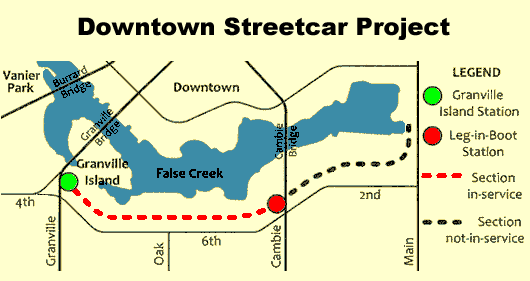
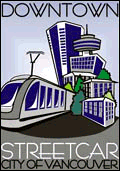
Vancouver City Council decided in March 2008 to support a transportation showcase project for the 2010 Olympic and Paralympic Winter Games. By January 2010, a demonstration version of the Downtown Streetcar will run between Granville Island and the new Canada Line Olympic Village Station using modern streetcars.
A demonstration Downtown Streetcar for the 2010 Winter Olympics will ensure reliable, accessible, and sustainable transportation for the athletes, visitors, and residents alike. Modern fully accessible streetcars could operate every six minutes between Granville Island and the future Canada Line Village Station. The demonstration portion of the future Downtown Streetcar line already has a dedicated rail right-of-way with 1.8 kilometres of track for 2 restored heritage streetcars that run on the weekends and holidays during the tourist season. This track is being replaced so both heritage and modern streetcars will be able to use it. This transportation showcase project will be an important first step in realizing the overall Downtown Streetcar line. It also signals a commitment to return the streetcar to Vancouver. Additional information may be found on their Downtown Streetcar Project website. (Note: The City of Vancouver has now removed that web site.)
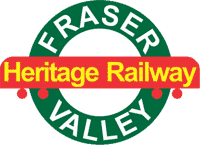
The Fraser Valley Heritage Railway Society's mission is to restore and operate heritage British Columbia Electric Railway Company passenger interurban cars on the original BC Electric Railway route through Surrey and the Fraser Valley to link heritage tourism destinations.
For limited operation by 2010 the Society has:
Revitalizing the Fraser Valley Line will link heritage tourism venues from Brownsville to Cloverdale in Surrey.
The FVHRS work program depends on:
With the opening of the Fraser River Bridge in 1904, the BC Electric Railway moved forward to establish a regional railway to serve the logging and agricultural communities on the south shore from Brownsville to Chilliwack that had been developing since 1860. The 63.8 mile long railway line provided passenger service from 1 Oct 1910 until 30 Sep 1950. It still provides freight service as the Southern Railway of BC. A heritage interurban running on the 13 mile Surrey segment could include stops at Brownsville Bar, Scott Road Sky Train station, Kennedy, Newton, and Cloverdale.
11 Jan 2006 - Restoration Under Way in Newton
18 Jan 2006 - BCER 1225 Progress Report
7 Apr 2006 - Early Days at Coghlan Station
2 May 2006 - Recreating a Symbol of Burnaby History
5 May 2006 - Search is on for Tram Memories
27 May 2006 - City Gets Heritage Tram for $400,000
18 Jun 2006 - Buzzer Marks 90 Years
11 Aug 2006 - B.C. Electric Building Restoration OK'd
5 Oct 2006 - Uncovering New West's Heritage
15 Oct 2006 - FVHRS Workshop - 1
15 Oct 2006 - FVHRS Workshop - 2
26 Oct 2006 - Tram Move to Britannia Off the Rails
2 Nov 2006 - Tram Station Gets Back to its Roots
14 Dec 2006 - Valley Rail Revival Dream Won't Die
17 Jan 2007 - Interurban History Topic of Talk
9 Feb 2007 - New Home Ready for Interurban
23 Feb 2007 - Suit Benefits Heritage Rail
3 Mar 2007 - Rail Dream is On Track
27 May 2007 - Tram Moving to Next Stop
2 Jun 2007 - Tram Move Stalled Again
12 Jul 2007 - Next Stop for Tram the Drawing Board
20 Aug 2007 - Who Owns the Interurban Line?
6 Sep 2007 - Pictures of Burnaby's History
25 Jan 2008 - Resurrect Tramline Residents Urge
11 Mar 2008 - Vancouver to Rebuild Streetcar Route
11 Mar 2008 - Vancouver Eyes Streetcar Project
11 Mar 2008 - New Streetcar Line Approved
17 Mar 2008 - Heritage Railway
6 Apr 2008 - Rehabilitating a Childhood Love
12 Jun 2008 - Historic Tram Stays Put
24 Jun 2008 - BCER Depot Wins Award
27 Jun 2008 - Heritage Interurban to Make Comeback
19 Jul 2008 - A Ride on BCER 1231
Downtown Historic Railway - Wikipedia
Fraser Valley Heritage Railway
Historic Places New West Depot (Link fails 24 Jan 2023)
Max Jacquiard
HO Scale Model Interurban Kits
This video follows the railway from Marpole Station in Vancouver, across the rail bridge to Lulu Island, and through Richmond to the line's terminus at Steveston. The end of the video shows two trains at Brighouse Station, the intersection of No. 3 Road and Granville Street. Filmed by interurban enthusiast Ted Clark it was donated to the City of Richmond Archives by the Clark family including about 5,500 photographs of the BCER system - Circa 1949.
Contains black and white images. Not currently available.
This is an absolutely incredible and exhaustive account of the BCER's history in Victoria, New Westminster, and Vancouver, but lacks any in-depth information about the BCER's bus services that started in the mid-1920's. Great book overall, a must-have for the local history lover in the Pacific Northwest.
On a Saturday afternoon a hundred years ago, public transit arrived in British Columbia as Car 1 of Victoria's street railway proudly set off down Store Street. Now, as we enter the 1990's, SeaBus carries three million people a year across Burrard Inlet, and the computerized SkyTrain crosses the City of Vancouver in a matter of minutes. The lively and fascinating story of what we know today as TransLink is beautifully designed and illustrated with hundreds of photographs, many in full colour.
Gaslights to Gigawatts is a human history that tells the story of BC Hydro and its predecessors through the memories and memoirs of the people who lived it. That story begins in the 1860's when gas lamps first illuminated the muddy streets of Victoria, and runs till the present era of billion watt power projects. Through hundreds of interviews and written submissions, the book includes the stories of line workers, dam builders, sales reps, bus drivers, and streetcar motormen, dietitians (someone had to teach customers how to cook on electric ovens), clerical staff, meter readers, labourers, managers and trade unionists. These are the countless people who dedicated their working lives to BC Hydro, and before it, to the BC Electric Company and the British Columbia Power Commission.
Step 1: To download this Wallpaper click on the small photo above which will enlarge it. After it is enlarged to its full size use your mouse to right click on the enlargement and a dialog box will appear. Within the dialog box select the option "Save image as..." A second dialog box will pop up showing the folders on your personal computer. Select your desired folder then click on the "Save" button. The image will then be downloaded to your computer.
Step 2: To install the image as Wallpaper on your screen right click on the Windows Start Button and select Settings - Personalization. Select the Browse button to locate the image where you previously saved it and Choose the image. Windows will install the image for you.